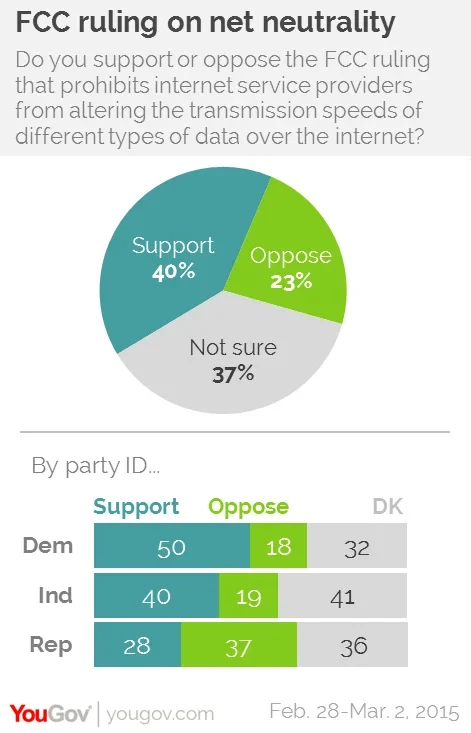Democrats and independents back the FCC’s new net neutrality rules, though many are undecided and Republicans are slightly opposed
Awareness of “net neutrality” as an issue has grown significantly over the past year. 52% now say they have heard of the term, up from 46% in November 2014 and 37% in May 2014. However, as YouGov’s past polling has shown, it’s an area where Americans have conflicting views: while people reject the idea of a “two-speed internet”, few think that, generally speaking, more regulation of internet service providers is needed (which would probably required for net neutrality).
However, evaluating the recent decision by the FCC to pass net neutrality regulations forces respondents to balance any desire for net neutrality with the prospect of new rules for businesses. YouGov’s latest finds that, asked specifically what they think about the FCC decision that prohibits ISPs from altering the transmission speeds of different kinds of data, Americans tend to side with net neutrality.

40% support the FCC decision upholding net neutrality, while 23% oppose it. A significant proportion (37%) of the public are undecided. Half of Democrats (50%) and many independents (40%) support the FCC decision, but Republicans tend to oppose (37%) rather than support (28%) the decision.
In a separate question, two in five (40%) said they had heard “nothing at all” about the FCC ruling, and only 18% had heard “a lot”, which might help explain why many Americans are not sure if they are for or against it.
The survey also shows that a large majority of Americans (74%) continue to side with the principle that "all data should be treated equally", while only 26% of Americans think that ISPs should be allowed to prioritize certain data traffic in order to reduce congestion at peak times. This is consistent with past YouGov polls. Of those who oppose paid prioritization, however, only half (50%) favor the FCC ruling. 17% in this group oppose it and 34% are undecided.
PA image
Full poll results can be found here and topline results and margin of error here.










